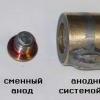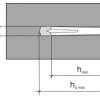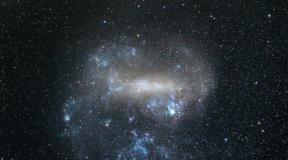Large and small Magellanic clouds. Magellanic Clouds Location of the Large Magellanic Cloud
Short description
The Large Magellanic Cloud occupies the region of the sky of the southern hemisphere in the constellations of the Dorado and Table Mountain and is never visible from the territory of Russia. The LMC is about 10 times smaller in diameter than the Milky Way and contains approximately 30 billion stars (1/20 of our galaxy), while the Small Magellanic Cloud contains only 1.5 billion stars. The mass of the LMC is approximately 300 times less than the mass of our galaxy (the mass of the LMC = 10 10 solar masses). The LMC is the fourth largest galaxy in the Local Group (after Andromeda, the Milky Way, and Triangulum). According to the figurative expression of F. Yu. Siegel, the Large Magellanic Cloud vaguely resembles a Segner wheel.
In 2013, the most accurate distance to the LMC was measured by an international team of astronomers. It is 163 thousand light years or 49.97 (± 0.19 (statistical error) ± 1.11 (systematic error)) kiloparsec. Observations have been made of eclipsing binary stars in the galaxy for almost ten years. Such stars turn very close to each other around a common center of mass, obscuring one another. At the same time, their overall brilliance decreases. So, tracking the pulsations of these stars, you can determine their masses, sizes and distances to them. According to Wolfgang Gieren (Universidad de Concepción, Chile), one of the team leaders, “Astronomers have been trying for a hundred years to accurately measure the distance to the Large Magellanic Cloud, and this has proven to be an extremely difficult task. And now we have solved this problem, having achieved a convincing measurement accuracy of 2%” .
Observation history
The first written mention of the Large Magellanic Cloud is contained in " Constellation book of fixed stars" by the Persian astronomer Abdurrahman al-Sufi ash-Shirazi (964), later known in Europe as "Azophi".
The next documented sighting was in 1503-1504 by Amerigo Vespucci.
The Large Magellanic Cloud is named after Ferdinand Magellan, who observed this galaxy in 1519 during a trip around the world.
Hubble Space Telescope measurements announced in 2006 indicate that the Large and Small Magellanic Clouds may be moving too fast to orbit the Milky Way. In 2014, Hubble Space Telescope measurements determined that the LMC has a rotation period of 250 million years.
As a result of observations in 2018-2019, a team of amateur astronomers received a record of its kind (not taking into account professional astronomy) image of the Large Magellanic Cloud. The total image resolution reaches 14,400 × 14,200 dots.
Objects
The most massive and brightest star in the LMC is R136a1located in the compact star cluster R136. It is a blue hypergiant with a mass equal to 265 solar masses. The surface temperature of a star is over 40,000 kelvin, it is 8.7 million times brighter than the Sun. Such superheavy stars are extremely rare and form only in very dense star clusters.
The largest star in the galaxy - WOH G64 - is also one of the largest known to science. Its radius is approximately 1540 solar radii. If WOH G64 is placed in the center of the solar system, then the surface will reach the orbit of Saturn. The star is also surrounded by a dense torus of dust and gas.
- The LMC shines 10 times fainter than the Milky Way, but is its brightest companion of two dozen satellite galaxies. Due to its gravity, the LMC pulls millions of stars from the Small Magellanic Cloud (LMC) towards it. There are several thousand orange and red giants in the galaxy, aging stars that are larger, brighter and colder than the Sun. About 5% of these stars have very special speed characteristics: they rotate at an angle of 54 degrees to the LMC plane, and also in the opposite direction compared to the bulk of the stars. The chemical composition of these stars also differs: in terms of the percentage of iron, they correspond to the MMO.
- Unlike most deep space objects, the LMC is not a separate NGC object.
- According to published data, according to one of the models, after 4 billion years the Milky Way will "absorb" the Large and Small Magellanic Clouds, and after 5 billion years the Milky Way itself will be absorbed by the Andromeda Nebula. According to the calculations of scientists from the Institute of Computational Cosmology at Durham University, the Large Magellanic Cloud, which is now moving away from the Milky Way, and in about 1 billion years, will turn around and head towards the center of our Galaxy, where they will merge over the course of about 1.5 billion years. In this case, the central supermassive black hole of our Galaxy Sagittarius A * will increase in size by 10 times. As a result of a collision in 2 billion years, the solar system can be pushed out of our galaxy into intergalactic space.
- According to scientists from the University of California at Riverside (USA), 1 billion years ago, the Carina Dwarf Galaxy, the Furnace Dwarf Galaxy and several other ultra-faint dwarf galaxies were satellites of the Large Magellanic Cloud, not the Milky Way.
Gallery
see also
Notes
- Pietrzyński, G; D. Graczyk; W. Gieren; I. B. Thompson; B. Pilecki; A. Udalski; I. Soszynski et al. An eclipsing-binary distance to the Large Magellanic Cloud accurate to two per cent // Nature: journal. - 2013. - March 7 (vol. 495, no. 7439). - P. 76-79. - DOI:10.1038/nature11878. - Bibcode : 2013Natur.495...76P. - arXiv :1303.2063 . - PMID 23467166 .
- SIMBAD Astronomical Database
- R. Brent Tully, Courtois H. M., Sorce J. G. Cosmicflows-3 // Astron. J./ J. G. III - IOP Publishing, 2016. - Vol. 152, Iss. 2.-P. 50–50. - ISSN 0004-6256; 1538-3881 - doi:10.3847/0004-6256/152/2/50
- Genevieve; Shattow; Loeb, Abraham. Implications of recent measurements of the Milky Way rotation for the orbit of the Large Magellanic Cloud // Monthly Notices of the Royal Astronomical Society: Letters: journal. - 2009. - Vol. 392 . - P.L21. - DOI:10.1111/j.1745-3933.2008.00573.x . - Bibcode : 2009MNRAS.392L..21S. - arXiv :0808.0104 .
- Macri, L. M. et al. A New Cepheid Distance to the Maser-Host Galaxy NGC 4258 and Its Implications for the Hubble Constant // The Astrophysical Journal : journal. - IOP Publishing, 2006. - Vol. 652, no. 2. - P. 1133-1149. - DOI:10.1086/508530 . - Bibcode : 2006ApJ...652.1133M. - arXiv :astro-ph/0608211 .
- Freedman, Wendy L; Madore, Barry F. The Hubble Constant (unknown) // Annual Review of Astronomy and Astrophysics. - 2010. - T. 48. - S. 673-710. - DOI:10.1146/annurev-astro-082708-101829 . - Bibcode : 2010ARA&A..48..673F. - arXiv :1004.1856 .
- Majaess, Daniel J.; Turner, David G.; Lane, David J.; Henden, Arne; Krajci, Tom. Anchoring the Universal Distance Scale via a Wesenheit Template // Journal of the American Association of Variable Star Observers: journal. - 2010. - Bibcode : 2011JAVSO..39..122M. - arXiv :1007.2300 .
- Peterson, Barbara Ryden, Bradley M. Foundations of astrophysics. - New York: Pearson Addison-Wesley, 2009. - P. 471. -
Like the giant planets of the solar system, our Milky Way has many satellites - small galaxies that are gravitationally connected to it. The most famous such objects are the Large and Small Magellanic Clouds. These are two dwarf galaxies, about 170,000 light-years away from us. They can be seen with the naked eye in the southern sky.
Astronomers have long known that some of the stars in the Large Magellanic Cloud are "wrong". Their velocities, orbits and chemical composition differ significantly from most of their neighbors. According to scientists, most likely these stars were stolen by the Large Magellanic Cloud from another galaxy. But which one?

Until recently, the Small Magellanic Cloud was considered as the main candidate for this role. The anomalous stars of its neighbor have a similar chemical composition to it. In addition, both galaxies are connected, consisting of hydrogen and a chain of stars. It is assumed that it was formed 200 million years ago, when both galaxies passed at a short distance from each other and the gravity of the Large Magellanic Cloud literally pulled out a stream of stars and gas from its neighbor.

However, in the latest issue of the journal Monthly Notices of the Royal Astronomical Society was, suggesting a different origin of the anomalous luminaries. Its author, Australian astronomer Benjamin Armstrong, conducted computer simulations that showed that the reason for everything could be the absorption of the Large Magellanic Cloud of a neighboring dwarf galaxy, which occurred 3 to 5 billion years ago. Such a process should lead to the appearance in the center of the galaxy of a large group of stars with retrograde orbits, which is very similar to the actually observed picture.

According to Armstrong, such a scenario could explain why stars in globular clusters of the Large Magellanic Cloud are either very old or very young without luminaries intermediate in age. The absorption of a neighboring galaxy should have provoked a powerful burst of star formation, as a result of which a large number of new luminaries were simultaneously formed.
Galaxy Research history Designations LMC, LMC ... Wikipedia
Exist., number of synonyms: 2 large number (24) galaxy (24) ASIS synonym dictionary. V.N. Trishin. 2013 ... Synonym dictionary
Large Magellanic Cloud- Large Magellan cloud (galaxy) ... Russian spelling dictionary
Dwarf galaxy, satellite of our Galaxy. We are separated from the Large Magellanic Cloud by 170,000 light years. It is one of the closest galaxies to us... Astronomical dictionary
Magellanic Cloud The term may refer to the following objects: Astronomical objects The Large Magellanic Cloud is a dwarf galaxy. The Small Magellanic Cloud is a dwarf galaxy. Literary works "Magellanovo ... ... Wikipedia
This term has other meanings, see Cloud (meanings). Small Magellanic Cloud Galaxy ... Wikipedia
A cloud is a large clot of water or other vapor (dust) in the atmosphere of the Earth or another planet. "A cloud in pants" poem by Vladimir Mayakovsky. Cloud 125 mm anti-hail multiple launch rocket system (12 barrel) Cloud weather radar MRL 1 ... ... Wikipedia
Ex., number of synonyms: 24 abyss (41) a large number (44) ... Synonym dictionary
- ... Wikipedia
Morphological classification of galaxies is a system for dividing galaxies into groups according to visual features, used in astronomy. There are several schemes for dividing galaxies into morphological types. The most famous was proposed ... ... Wikipedia
If you ever happen to spend the night south of the Earth's equator, and the southern velvet-black sky will spread unusual patterns of constellations in front of you (for some reason, you always want to believe that somewhere there, beyond the seas, there is always good weather), pay attention to two small misty clouds in the sky. These "abnormal" clouds do not move relative to the stars and seem to be "glued" to the sky.
In Europe, mysterious clouds were known as early as the Middle Ages, and the indigenous inhabitants of the equatorial regions and the lands of the southern hemisphere knew about them, apparently, long before that. In the 15th century, sailors called the clouds Cape (the name is akin to the name of the Cape Colony - medieval British possessions in South Africa, located on the territory of the current Republic of South Africa).
The south pole of the world, unlike the north, is more difficult to find in the sky, since there are no such bright and conspicuous stars as the Polar one next to it. The Cape Clouds are located near the south pole of the celestial sphere and form an almost equilateral triangle with it. This property of the Clouds made them well-known objects, and therefore they have long been used in navigation. However, their nature remained a mystery to scientists of that time.
During the round-the-world trip of Ferdinand Magellan in 1518-1520, his companion and chronicler Antonio Pigafetta described the clouds in his travel notes, which made the fact of their existence the property of the general European public. After Magellan died in 1521 in an armed conflict with the local population in the Philippines, Pigafetta suggested calling the clouds Magellanic - Large and Small, according to their size.
Visible to the eye, the size of the Magellanic Clouds in the sky is one of the largest among all astronomical objects. The Large Magellanic Cloud (LMC) has a length of more than 5 degrees, i.e. 10 apparent diameters of the moon. The Small Magellanic Cloud (LMC) is slightly smaller - just over 2 degrees. In the photographs, where it is possible to fix weak outer regions, the sizes of the Clouds are 10 and 6 degrees, respectively. The Small Cloud is located in the constellation Tucan, and the Large Cloud occupies part of the Golden Fish, as well as Table Mountain.
Even at the beginning of our century, scientists did not have a single opinion about the nature of the Clouds. The encyclopedia of Brockhaus and Efron, for example, says that the Clouds are "not solid spots like others; they represent the most amazing accumulations of many foggy spots, stellar heaps and individual stars." And only after astronomers measured the distances to some nebulae in the 1920s, and it became clear that there are stellar worlds that lie far beyond our Galaxy, the Magellanic Clouds occupied their "niche" among celestial objects.
It is now known that the Magellanic Clouds are the closest neighbors of our Galaxy in the entire Local Group of galaxies. Light from the LMC takes 230 thousand years to reach us, and even less from the MMO - "only" 170 thousand years. For comparison, the nearest giant spiral galaxy, the Andromeda Nebula, is almost 10 times further away than the LMC. The linear dimensions of the Clouds are relatively small. Their diameters are 30 and 10 thousand light years (recall that our Galaxy has more than 100 thousand light years across).
The clouds have a shape and structure typical of irregular galaxies: irregularly distributed areas of increased brightness stand out against the background of a ragged structure. And yet there is order in the structure of these galaxies. In the LMC, for example, there is an orderly movement of stars around the center, which makes this Cloud look like "regular" spiral galaxies, the stars in the galaxy are concentrated to a plane called the plane of the galaxy.
By the motion of the matter of the Clouds, one can find out how their galactic planes are located. It turned out that the LMC lies almost "flat" on the celestial sphere (the inclination is less than 30 degrees). This means that all the complex "stuffing" of the Big Cloud - stars, clouds of gas, clusters - are located almost at the same distance from us, and the observed difference in the brightness of various stars is true and is not distorted due to different distances to them. In our Galaxy, only stars in clusters have this property.
The successful orientation of the LMC, its "openness", as well as the proximity of the Magellanic Clouds to us made them a real astronomical laboratory, "object number 1" for the physics of stars, star clusters and many other interesting objects.
The Magellanic Clouds have brought some surprises to astronomers. One of them was star clusters. They have been found in the Magellanic Clouds, as well as in our galaxy. About 2000 of them were found in the MMC, more than 6000 in the LMC, of which about a hundred are globular clusters. There are several hundred globular clusters in our Galaxy, and all of them contain anomalously few chemical elements heavier than helium. In turn, the content of metals clearly depends on the age of the object - after all, the longer the stars live, the longer they enrich the "environment" with chemical elements heavier than helium. The low content of metals in the stars of globular clusters of our star system indicates that their age is very advanced - 10-18 billion years. These are the oldest objects in our Galaxy.
A surprise awaited astronomers who measured the "metallicity" of clusters in the Clouds. More than 20 globular clusters have been discovered in the LMC, which have the same metal content as stars that are not yet very old. This means that, by the standards of astronomical objects, the clusters were born not so long ago. There are no such objects in our Galaxy! Consequently, in the Magellanic Clouds the formation of globular clusters continues, while in the Galaxy this process ceased many billions of years ago. Most likely, gigantic tidal forces in our stellar system have time to "pull apart" the unborn globular clusters. In the Magellanic Clouds, small in size and mass, in a more "polite" environment, there are all conditions for the formation of globular star clusters.
The Clouds themselves do not stand out in the world of galaxies because of their modest size and luminosity. However, there is an object in the Large Magellanic Cloud that is a prominent figure among its own kind. We are talking about a huge, hot and bright cloud of gas, which is clearly visible in the photographs of the LMC. It's called the Tarantula Nebula, or, more formally, 30 Dorado. The name Tarantula was given to the nebula because of its appearance, in which a person with a rich imagination can see the resemblance to a large spider. The length of the nebula is about a thousand light years, and the total mass of gas is 5 million times the mass of the Sun. The Tarantula glows like several thousand stars combined. This is because massive hot stars are born inside the nebula, emitting much more energy than stars like our Sun. They heat up the gas around them and make it glow. There are only a few nebulae of similar size in our galaxy, but they are all hidden from us by a dense veil of galactic dust. If not for the dust, they would also be visible and bright celestial objects.
Inside the Tarantula Nebula are many star birth centers where stars are born "in bulk". Young massive stars, whose age does not exceed several million years, show us those regions where the formation of stars from gas clumps is still ongoing.
Inside the Tarantula, supernovas have also repeatedly exploded. Such explosions of stars at the final stage of their evolution lead to the fact that most of the star is scattered across space at speeds of several thousand kilometers per second. Supernova explosions have made the structure of the nebula confusing, chaotic, filled with intersecting gaseous filaments and shells. The Tarantula Nebula serves as a good testing ground for theories of the birth and death of stars.
The Magellanic Clouds also played an important role in the construction of the intergalactic distance scale. Over 2000 variable stars have been found in the Clouds, most of which are Cepheids. The period of change in the brightness of Cepheids is closely related to their luminosity, which makes these stars one of the most reliable indicators of the distance to galaxies. Using the Clouds as an example, it is very convenient to compare various distance indicators, according to which the intergalactic "ladder" of distances is built.
If the human eye were capable of perceiving radio waves with a wavelength of 21 cm (atomic hydrogen emits at this wavelength), then it would see an amazing picture in the sky. He would have seen dense clouds of gas in the plane of our Galaxy - the Milky Way, and individual clouds at different latitudes - nearby gas nebulae and clouds "wandering" at high latitudes. The Magellanic Clouds would change amazingly. Instead of two separated objects, a "longwave" person would see one large cloud with two bright condensations where we are used to seeing the Large and Small Magellanic Clouds.
Back in the 1950s, it was found that clouds are immersed in a common gas envelope. The shell gas continuously circulates: cooling in intergalactic space, it falls on the Clouds under the action of gravity and is pushed back by supernova "pistons", as a result of which an expanding shell of hot gas with excess pressure inside appears (this process resembles the movement of water in a saucepan heated from below gas burner).
Recently it has also become clear that the Clouds are connected by a common gas bridge not only with each other. A filament of gas has been found - a thin band of gas starting in the Clouds and going across the entire sky. It links the Magellanic Clouds to our Galaxy and several other galaxies in the Local Group. It was called the "Magellan Stream". How did this stream come about? Most likely, several billion years ago, the Magellanic Clouds approached our Galaxy. Our giant star system "pulled out" some of the gas from the Clouds with its gravitational pull, like a vacuum cleaner. This gas partially enriched our star system. The rest of it "splashed" in intergalactic space, forming the Magellanic Stream.
The proximity of the Magellanic Clouds to our massive Galaxy is not in vain for them. It is possible that the convergence of the Clouds and the Milky Way, causing the exchange of gas and stars, occurred more than once in the past. If the nearest of the clouds - Small, comes to our Galaxy 3 times closer than it is now, tidal forces will completely destroy it. In the distant future, similar collisions may occur, and the Magellanic Clouds will be completely absorbed by our Milky Way. They will not soon be "digested" in the huge belly of our Galaxy, and activate the birth of stars in the places of their fall, as is observed in a stronger form during the merger of large galaxies.
The Large Magellanic Cloud is both a guiding object for navigators and an interesting space formation that has attracted the attention of astronomers for centuries.
The dark sky of the Southern Hemisphere is colored with myriads of luminous dots, among them a bright cloud-shaped cluster of stars is clearly distinguishable. These are faithful satellites of our native Milky Way - the Large and Small Magellanic Clouds. For many centuries they serve as the only reference point for travelers in the southern latitudes. The description of these accumulations came to Europe with the ships of the first round-the-world navigator Ferdinand Magellan.

The constellation Golden Fish, the Large Magellanic Cloud is at the bottom of the diagram
Writing down all the significant events of the journey, making notes about everything he saw, Pythaghetta in 1519 told the inhabitants of the Northern Hemisphere about the clouds they had never seen. They also owe their modern name to the grateful companion of Magellan. After the tragic death of the pioneer in a battle with the natives, the chronicler proposed in this way to perpetuate the memory of the great traveler.
Dimensions and properties
After crossing the equator towards the south, you can see the Large Magellanic Cloud (LMC), which is a special world, a separate galaxy. In size, it is noticeably inferior to the Milky Way, like all satellites - to the central objects. LMC moves in a circular orbit, experiencing a strong influence of the gravity of our Galaxy. The size of this cluster of stars is estimated at 10 thousand light years, and in terms of the mass of cosmic bodies and gas in it, it is 300 times inferior to the Milky Way. Our planet and the LMC are separated by a distance of 163 thousand light years, but still, it is our closest neighbor among the distant worlds of the Local Group. At the beginning of the study, the Magellanic Clouds were attributed to irregular galaxies that did not have a well-defined structure, but new facts helped to notice the presence of spiral arms and a bar. The dwarf galaxy was assigned to the SBm subcategory.
Location and composition

Occupying a significant part of the constellation Dorado, the Large Magellanic Cloud includes 30 billion stars. It is much larger and closer to the Earth than the Small Cloud associated with it by the flow of hydrogen and the common gas veil. In its study, begun by the Persians in the 10th century, scientists were able to advance significantly. The successful location of the object and the fact that all its components are at approximately the same distance affected here. Many unique objects that fill a small galaxy: nebulae, supergiant stars, globular clusters, Cepheids, have become sources of invaluable knowledge about the evolution of the universe.
Systematic observations of eclipses of stars and changes in their brightness helped to accurately calculate the distance to cosmic bodies, their size and mass. The study of the Large Magellanic Cloud has yielded many important discoveries that cannot be overestimated. A dynamics uncharacteristic for a solid age of our Galaxy, accompanying the appearance of new stars, has been noticed. For the Milky Way, such processes ended several billion years ago. The Big Cloud, on the other hand, contains thousands of type I objects containing a large amount of the metal inherent in young stars.
Significant BMO objects

Image of the Tarantula Nebula using Ha, OIII and SII filters. Total exposure time 3.5 hours. Posted by Alan Tough.
A famous area where vigorous star formation occurs is the Tarantula Nebula, so named for its resemblance to a giant spider. In the LMO images, this place stands out with particular brightness. Inside a cloud of gas, a thousand light-years across, new stars are born, throwing colossal energy into the space that covers them, and causing it to glow.
Cataclysms accompanying the end of the life cycle of stars are not uncommon in a nebula. Astronomers recorded such a release of energy in 1987 - it was the closest flare to the Earth of all noted. The central part of the "Tarantula" is known for the unique object located here, named R131a1. It is represented by the most massive of the studied stars, which exceeds the Sun by 265 times in weight, and by 10 million times in luminous flux.
One of the unique stars of the Large Magellanic Cloud became the ancestor of a separate class of luminaries. S Doradus is a hypergiant, quite rare, having a huge mass and luminosity, existing for a short time. His name has been used to name a class of blue variable stars. The luminous flux emitted by it exceeds the solar one by 500 thousand times. In addition to the listed blue giants, it is necessary to single out the LMC star WHO G64. This is a red supergiant, its temperature is low - 3200 K, the radius is 1540 radii of our star, and the brightness is 280 thousand times higher.

Watching the billions of stars that fill the Large Magellanic Cloud, it is noticed that some of them move in the opposite direction and differ in their composition. These are objects stolen by the galaxy's gravity from its neighbor, the Small Cloud. The location of the LMC in the Southern Hemisphere deprives the inhabitants of the northern latitudes of the opportunity to observe it. And if S Doradus replaced the nearest star to us, there would be no dark time of day on Earth.
Read also...
- How to drink Flemoxin before meals or after
- Why dream of levitation To soar in a dream in the air without wings: what does it mean
- Interesting facts about insurance (10 photos)
- "Yarina" or "Janine": which is better, composition of drugs, effectiveness, tips for choosing Change in the date of the onset of menstruation



















